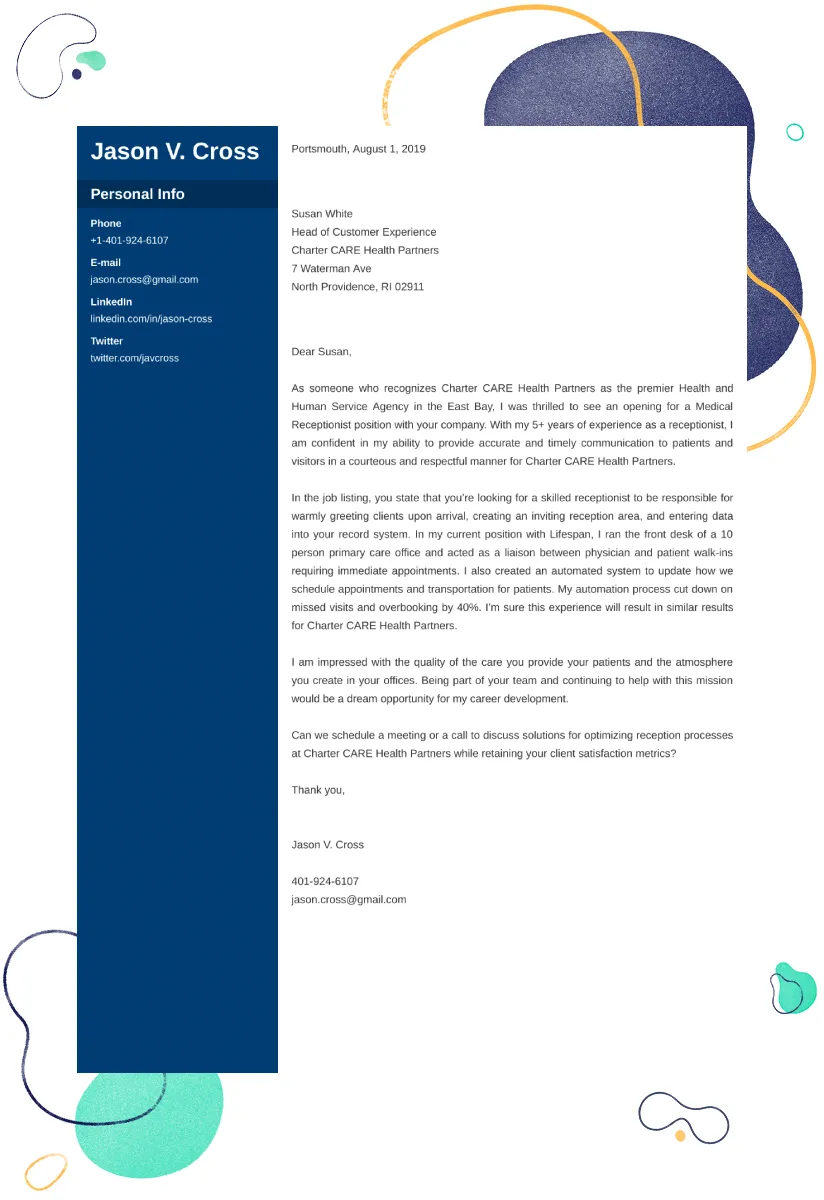A well-crafted receptionist cover letter is your first opportunity to impress a potential employer and secure an interview. It’s more than just a formality; it’s your chance to showcase your personality, highlight relevant skills, and demonstrate your enthusiasm for the role. This guide provides a sample cover letter receptionist, offering a step-by-step approach to crafting a compelling letter that grabs attention and increases your chances of landing the job. By understanding the key components and tailoring your letter to each specific opportunity, you can significantly improve your application and stand out from the competition. Remember that the best receptionist cover letter examples are those that are specifically tailored to the role and company.
Key Components of a Receptionist Cover Letter
The structure of your cover letter is crucial. A well-organized letter is easy to read and allows the hiring manager to quickly find the information they need. Each element serves a specific purpose, and when combined, they create a professional and persuasive document. Ensure that you meticulously adhere to the standard format, as this demonstrates attention to detail, a highly valued quality in a receptionist. The format should also align with the overall tone of your application, highlighting your experience and enthusiasm for the position. This layout ensures that you present yourself in the best possible light, making a strong first impression.
Contact Information
Your Name and Contact Details
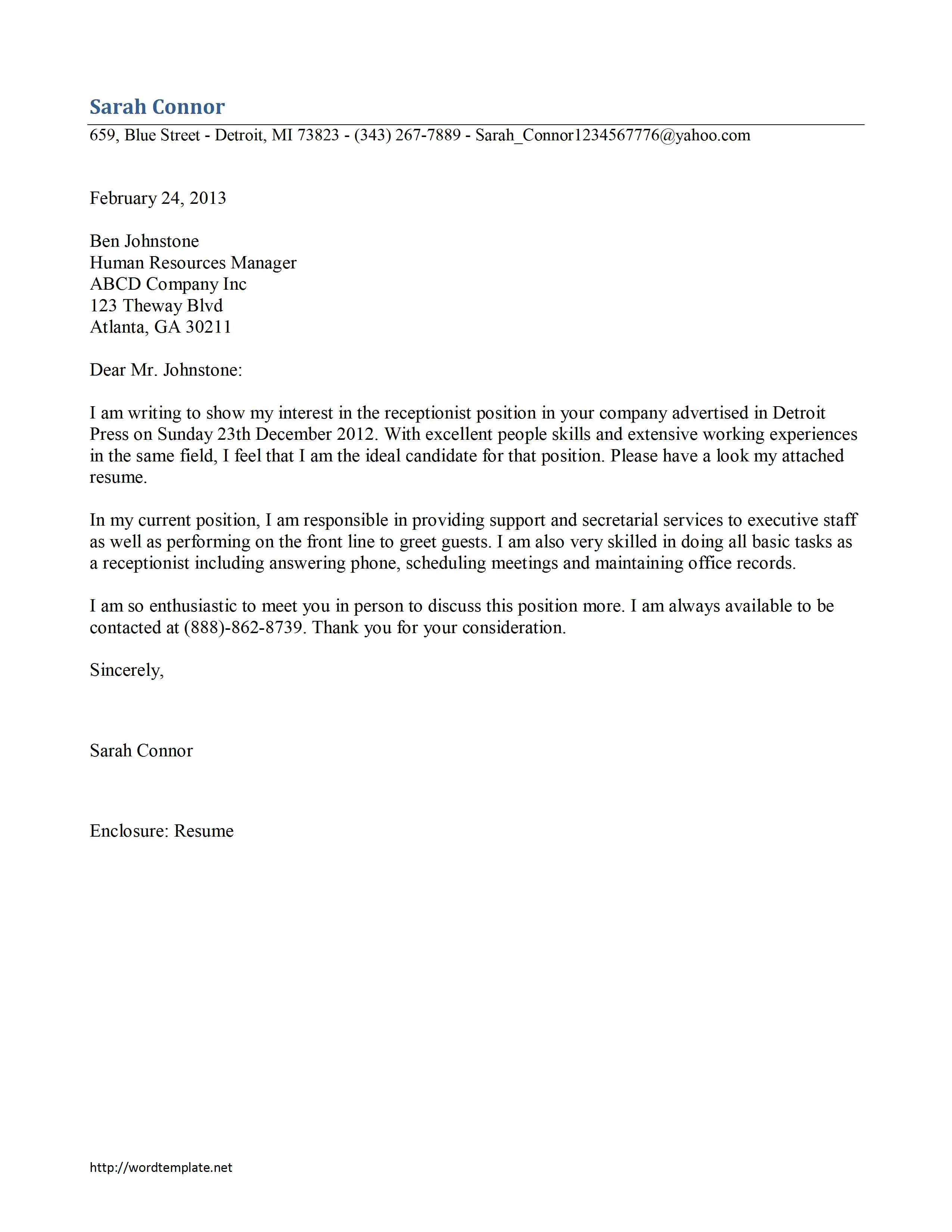
Begin your cover letter with your full name, address, phone number, and email address. This should be placed at the top left or right of the letter. Ensure your email address is professional-sounding. This information is essential for the employer to contact you. Double-check that all the contact details are accurate and up-to-date to avoid any delays in communication. Remember, accuracy in this section speaks volumes about your attention to detail.
Date and Recipient Information
Below your contact information, include the date and the recipient’s details. This includes the hiring manager’s name (if known), their title, and the company’s address. If you can find the hiring manager’s name, it’s a good idea to address the letter to them directly. It shows you’ve done your research and are taking a personal approach. If the name is not available, use a general greeting like ‘Dear Hiring Manager’.
Professional Greeting
Start your cover letter with a professional greeting. ‘Dear Mr./Ms. [Last Name]’ is appropriate if you know the hiring manager’s name. If not, use ‘Dear Hiring Manager’ or ‘Dear [Company Name] Hiring Team’. Avoid casual greetings. This sets a professional tone right from the beginning and demonstrates respect for the recipient. Proper salutation is crucial, showcasing your understanding of professional etiquette. A well-chosen greeting immediately establishes a positive impression, and can also make your application more personalized and attractive.
Opening Paragraph Grabbing Attention
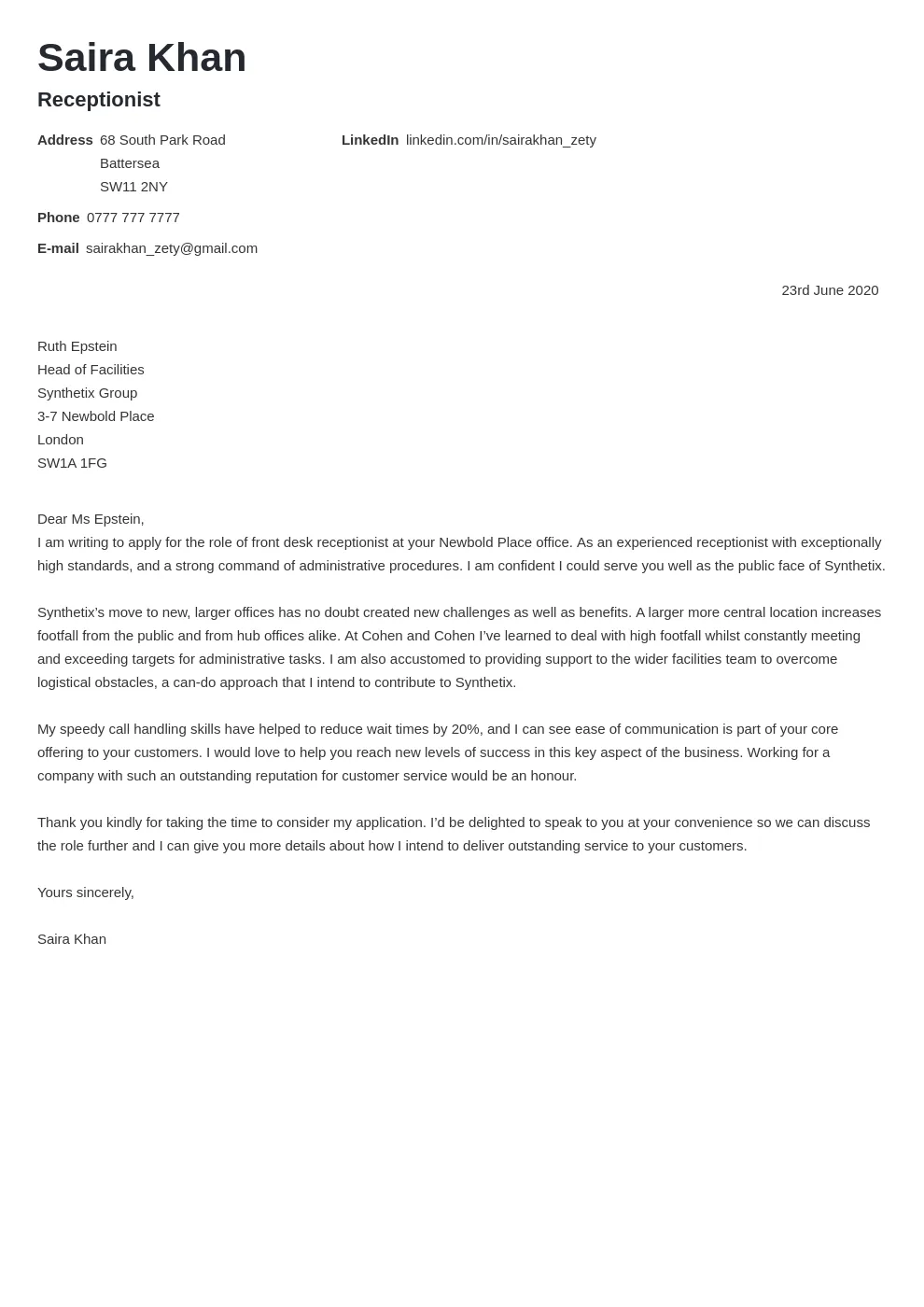
The opening paragraph is your chance to make a strong first impression. It should immediately grab the reader’s attention and express your interest in the position. Clearly state the specific role you’re applying for and where you found the job posting. Briefly mention why you are interested in the company and what excites you about the opportunity. A compelling opening makes the reader want to continue reading, encouraging them to delve deeper into your skills and experience. The goal is to hook the reader and make them want to know more about you and why you’re the right candidate. Tailor this paragraph to each specific job, showing your enthusiasm and knowledge of the company.
Highlighting Relevant Skills
Receptionist roles require a specific set of skills. In this section, highlight the skills that make you a perfect fit for the job. Use specific examples and quantifiable achievements whenever possible to demonstrate your abilities. Don’t just list skills; explain how you’ve used them in previous roles. The employer wants to see that you can meet the responsibilities of a receptionist. Focus on the skills that best align with the job description, illustrating that you understand the core requirements. Providing concrete examples is essential for demonstrating your competence and showing that you’re a valuable asset to the team.
Communication Skills
Receptionists are the first point of contact for many organizations. Therefore, excellent communication skills are paramount. Emphasize your ability to communicate clearly and effectively, both verbally and in writing. Include examples of how you’ve handled difficult customers or provided exceptional service. Showcase your active listening skills, your ability to maintain a positive and professional demeanor, and how you tailor communication to different audiences. Show how you can communicate effectively with different groups of people. The ability to communicate effectively is key for all receptionist jobs.
Organizational Abilities
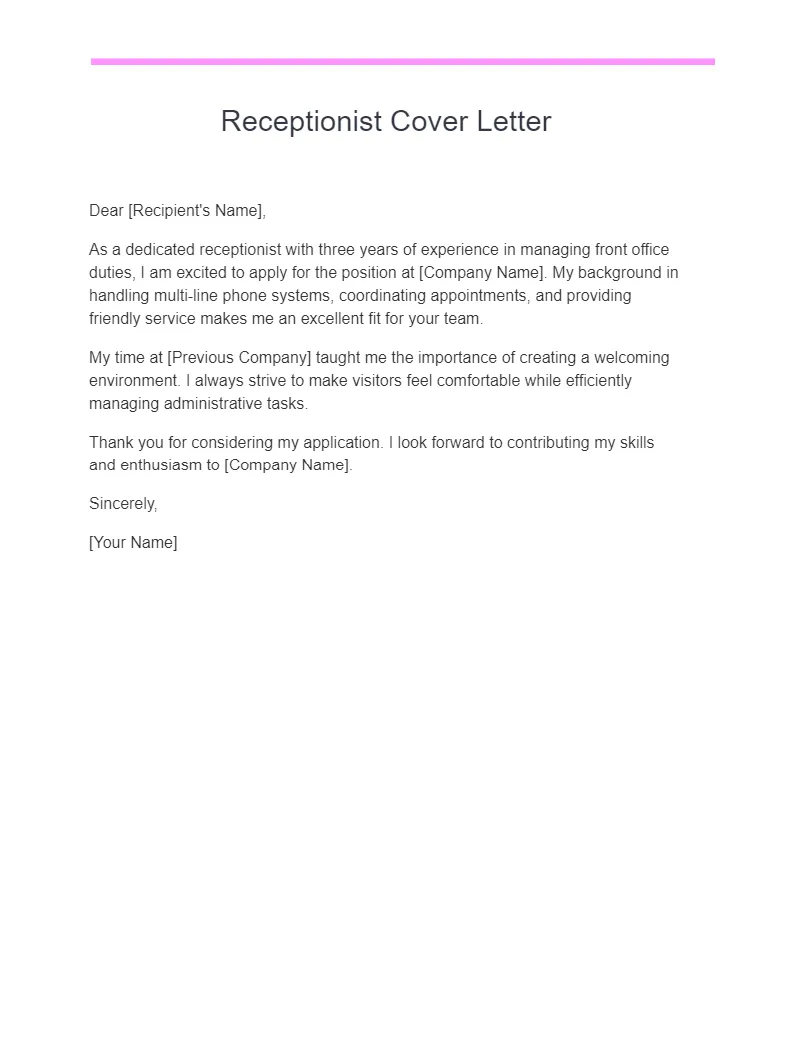
Receptionist roles demand excellent organizational skills. Highlight your ability to manage schedules, handle multiple tasks simultaneously, and maintain an organized workspace. Describe your experience with scheduling software, managing appointments, and organizing documents. Give specific examples of how you’ve improved efficiency or streamlined processes in previous positions. These abilities show you are well-prepared to handle the multitasking that is essential for a receptionist to successfully complete all their tasks.
Customer Service Prowess
Customer service is at the heart of the receptionist’s role. Describe your experience in providing excellent customer service, including how you handle inquiries, resolve issues, and create a welcoming environment. Provide specific examples of how you’ve gone above and beyond to assist customers or clients. Showcase your patience, empathy, and ability to remain calm under pressure. Mention any positive feedback or awards you’ve received for your customer service skills. This will provide a detailed picture of your customer service expertise.
Showcasing Experience
Provide a brief overview of your previous work experience, focusing on roles and responsibilities that are relevant to the receptionist position. Highlight your achievements and the skills you developed in these roles. Use action verbs to describe your duties and accomplishments. If you have limited experience, emphasize transferable skills and any relevant volunteer work or educational achievements. Be concise, and tailor this section to the job description. This will show the employer your relevant experiences.
Addressing the Employer’s Needs
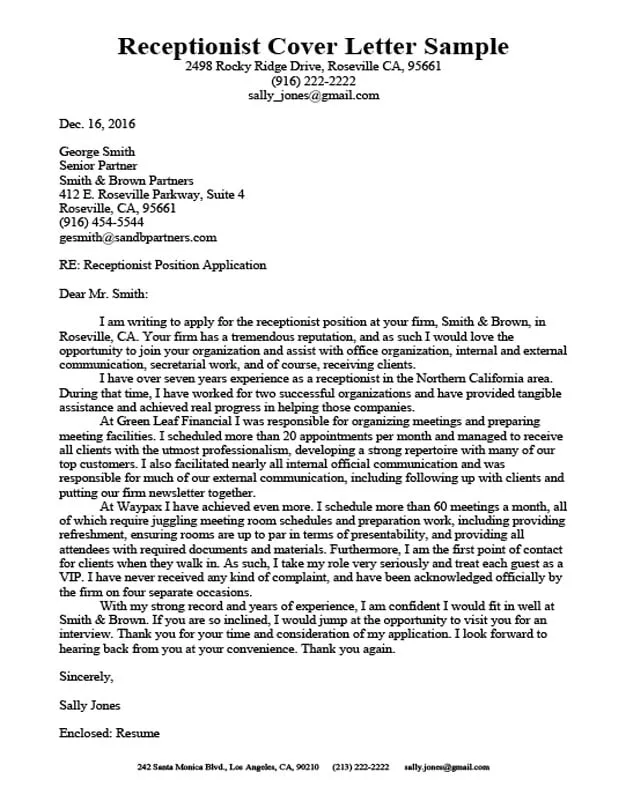
In the main body of your cover letter, show how your skills and experience align with the employer’s needs. Research the company and tailor your letter to address their specific requirements. Refer directly to the job description and use the same keywords they use. Show how you can contribute to their organization and what value you can bring. A customized letter demonstrates that you’ve taken the time to understand their needs and are genuinely interested in the role. Demonstrate your understanding of what the company seeks in a receptionist, and demonstrate how you meet those expectations.
Expressing Enthusiasm
Express your enthusiasm for the opportunity and the company. Explain what excites you about the position and why you’re interested in working there. Show that you have done your research and understand the company’s mission and values. Highlight aspects of the company that you admire or appreciate. Demonstrate your passion and your commitment to the role. Your enthusiasm can be a powerful factor in setting you apart from other candidates. Expressing your genuine enthusiasm will significantly increase your chances of making a lasting impression on the hiring manager.
Closing and Call to Action
End your cover letter with a strong closing that includes a call to action. Thank the employer for their time and consideration. State your availability for an interview and how they can contact you. Reiterate your interest in the position and express your anticipation of discussing your qualifications further. Make it easy for them to take the next step. A strong call to action invites them to reach out to you, creating a sense of momentum and indicating your interest in the role. This final section is your last opportunity to leave a positive impression.
Formal Closing and Signature
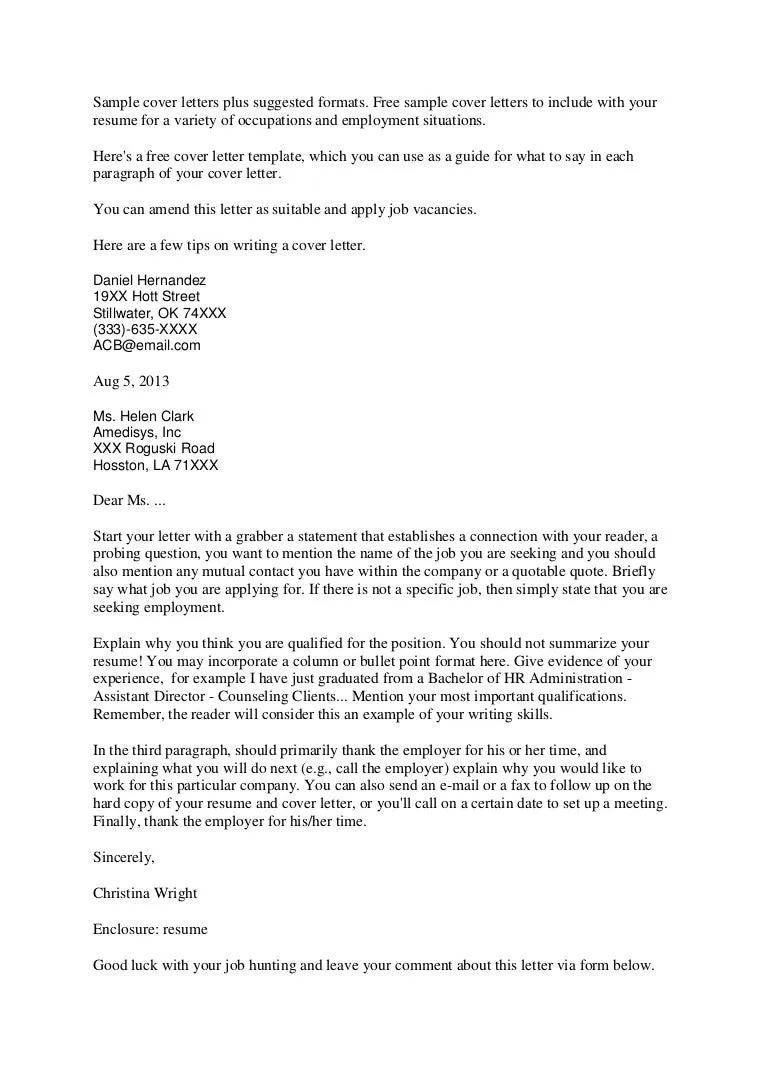
Use a formal closing such as ‘Sincerely,’ ‘Best regards,’ or ‘Yours sincerely,’ followed by your typed name. If you’re submitting a physical letter, leave space for your signature above your typed name. Keep the tone professional and respectful. The closing paragraph should reaffirm your professionalism and show that you are ready to take the next steps. Keep it concise and to the point, ensuring that the ending aligns perfectly with your overall cover letter. Consider including a digital signature on your letter, if you are submitting it electronically. (Image receptionist-professionalism.webp)
Thanking the Employer
Always thank the employer for their time and consideration. Express your appreciation for them reviewing your application. This shows respect and leaves a positive final impression. Your thank-you can be brief but heartfelt. It reinforces your professionalism and leaves a lasting positive impact. A simple thank-you can go a long way and will help in strengthening your overall impression.
By following these guidelines, you can create a compelling receptionist cover letter that impresses potential employers and increases your chances of getting an interview. Remember to tailor your letter to each job application and always proofread for any errors. Good luck with your job search!
